10+ Taking Minutes Examples to Download
A successful and effective meeting requires you to document essential details and agreements. If you are the meeting’s sacred scribe, you must know how to write and share meeting minutes efficiently, intuitively, and effortlessly with your coworkers. Meeting minutes are the written records of a meeting used to inform participants and non-attendees of what the topic is all about. Also, this identifies the necessary next steps to keep the discussion or project on track.
If you lack an idea about this topic, don’t worry. Here are sample templates and steps that you can use:
10+ Taking Minutes Examples in PDF
1. Taking Minutes Template
2. Taking Minutes in a Meeting
3. Taking Minutes Example
4. Template for Taking Minutes
5. Business Taking Minutes
6. Taking Board Meeting Minutes
7. Taking Minutes in PDF
8. Sample Taking Meeting Minutes
9. Adult Taking Minutes
10. Taking Minutes of Meeting in PDF
11. Effective Minute Taking
What Is Taking Minutes?
Taking minutes or also is a written record of all the things that happened at a meeting. They serve as a reminder to those who were unable to attend the conference. Also, this can help track the things agreed upon during the agreement. As such, you can revisit it and use it to guide future decisions. However, there are specific abilities that you may possess while taking a minute. Some of such are the following:
- Active Listener
- Detail-Oriented
- Reasonably Confident
- Equipped With Materials
How To Write Effective Meeting Minutes?
Preparing meeting minutes doesn’t have to be a difficult task either you are a secretary of your organization or only a member who asks to take note of everything. However, make sure that you are aware of the factors to consider when doing so. Because the minutes are a permanent record of the meeting, double-check them before submitting them. Make sure to run them by a supervisor or seasoned attendee to secure that information and statements accurately taken.
To get you started with writing, here are some steps to consider:
Step 1. Create an Agenda
Meetings happened for a reason. That’s why you should list down the issue that needs attention to alert your attendees. In this case, you can work with the convener to create a topic that assigns time to each problem. It can help you keep the meeting going and ensure that everyone has enough time to consider all items. The program serves as your outline for meeting minutes. So, keep the minute’s heading consistent with the list topics for continuity.
Step 2. Use a Template From Previous Minutes.
If you’re new to the organization, writing meeting minutes for the first time can be challenging. In this case, don’t hesitate to ask for the past notes to maintain the same format. The previous meetings can help you determine whether a quorum succeeds. Or if the other details unique to the organization’s meeting minutes.
Step 3. Record Attendance
In an organization meeting, the minute’s taker should arrive early before the meeting start. He or she should pass around the sheet that has all the member’s names and contact information. Attendees must check off their names and make any necessary changes to their data. It can serve as a backup document for attendees. As well as a way to guarantee that information sent are their current email addresses.
Step 4. Proofread Carefully
In taking minutes, you no need to write down everything. There are only specific factors that you need t take note like checking the spelling, date of the meeting, and the minutes. Don’t forget to pell out acronyms, especially if it’s their first time to attend. Stay consistent with the punctuation, heading, and formatting. The minutes should be professionals.
FAQs:
What’s the importance of taking minutes?
As a glimpse, meeting minutes are detailed documents of the proceedings to take place during a meeting. It highlights the essential details, assignments, and decisions. With this, you can avoid misunderstandings and disagreements because you can review the minutes and determine what occurred unusually at the conference.
What is involved in meeting minutes?
When it comes to meeting minutes, people are unaware of the things that need to take note of. And this will be an extensive problem in the end. As a staff member or even a manager, do some research before you start. Don’t risk your project because of such reasons. Some of the factors that involve taking minutes are; date and time, name of the participants, acceptance or corrections, and decisions made about each plan.
What’s the most challenging part of writing meeting minutes?
Knowing what to write down and what to leave out is one of the most complex aspects of taking minutes. Remember these two key points: Do not try to write everything on your sheet– it’s impossible and useless. Minutes are not a verbatim statement of what was said.
Meeting minutes don’t have to be hard to write. There are tools and meeting minute templates that you can get online. Either you are recording company-wide conference calls or only syncing up with your current project, make use of your time smartly. Take the sample templates above!
10+ Taking Minutes Examples to Download

A successful and effective meeting requires you to document essential details and agreements. If you are the meeting’s sacred scribe, you must know how to write and share meeting minutes efficiently, intuitively, and effortlessly with your coworkers. Meeting minutes are the written records of a meeting used to inform participants and non-attendees of what the topic is all about. Also, this identifies the necessary next steps to keep the discussion or project on track.
If you lack an idea about this topic, don’t worry. Here are sample templates and steps that you can use:
10+ Taking Minutes Examples in PDF
1. Taking Minutes Template

wordpress.com
Details
File Format
PDF
Size: 287 KB
2. Taking Minutes in a Meeting
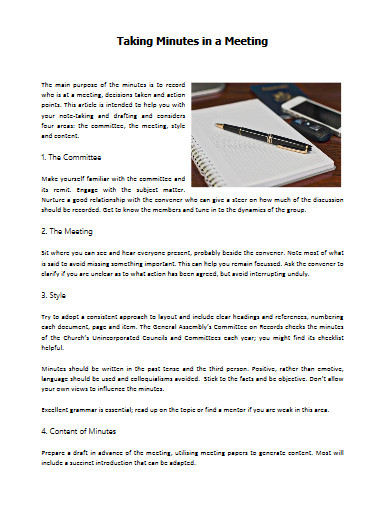
churchofscotland.org.uk
Details
File Format
PDF
Size: 408 KB
3. Taking Minutes Example
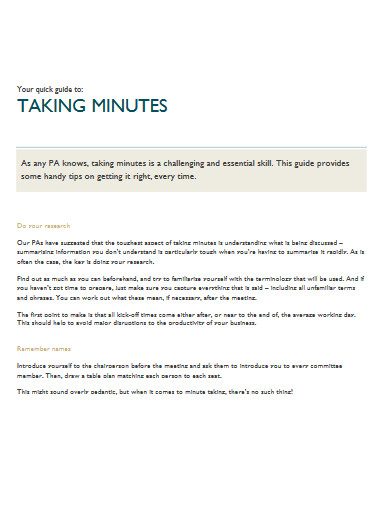
tate.co.uk
Details
File Format
PDF
Size: 249 KB
4. Template for Taking Minutes
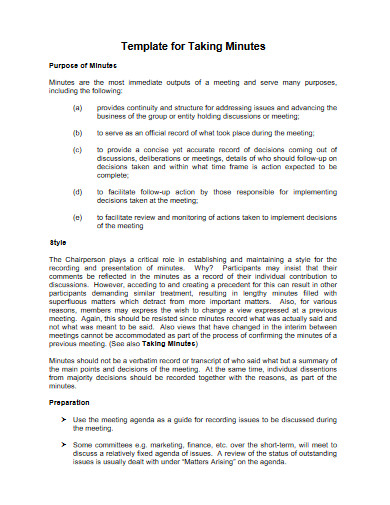
caribbeanhotelandtourism.com
Details
File Format
PDF
Size: 29 KB
5. Business Taking Minutes
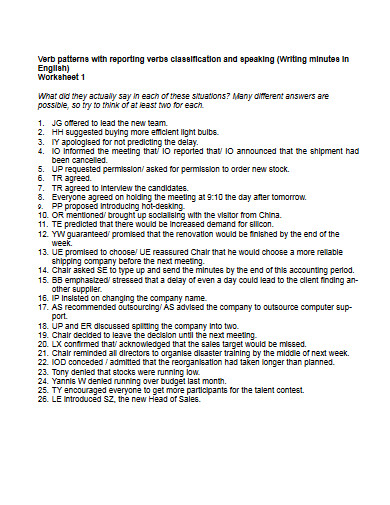
usingenglish.com
Details
File Format
PDF
Size: 108 KB
6. Taking Board Meeting Minutes
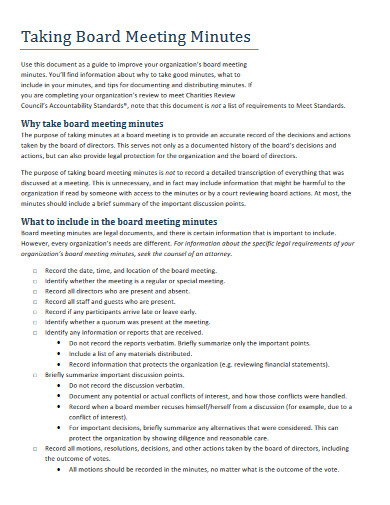
smartgivers.org
Details
File Format
PDF
Size: 588 KB
7. Taking Minutes in PDF
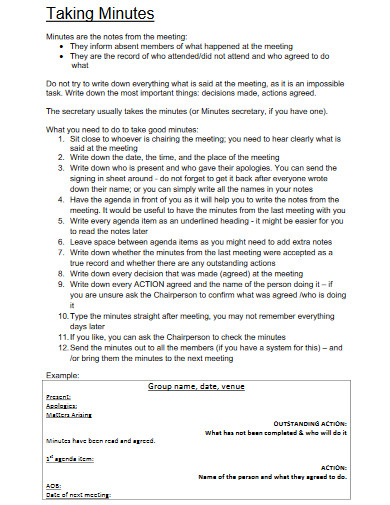
southampton.gov.uk
Details
File Format
PDF
Size: 57 KB
8. Sample Taking Meeting Minutes
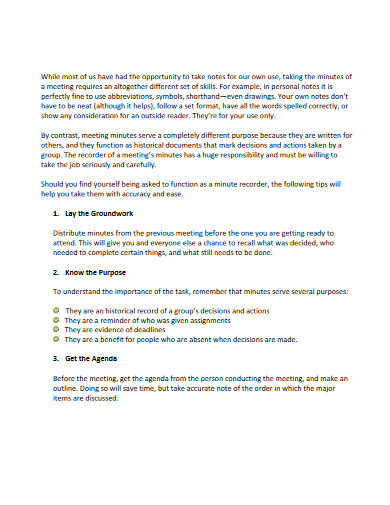
training.org
Details
File Format
PDF
Size: 484 KB
9. Adult Taking Minutes
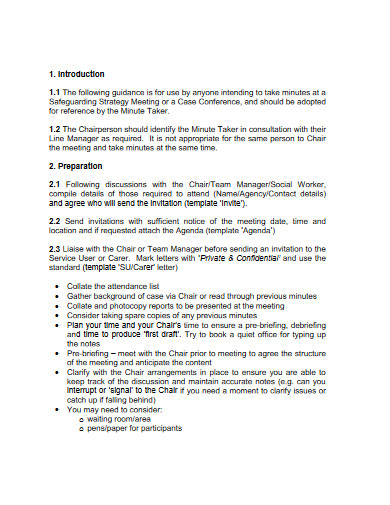
safeguardingpeterborough.org.uk
Details
File Format
PDF
Size: 227 KB
10. Taking Minutes of Meeting in PDF

ireland.anglican.org
Details
File Format
PDF
Size: 230 KB
11. Effective Minute Taking
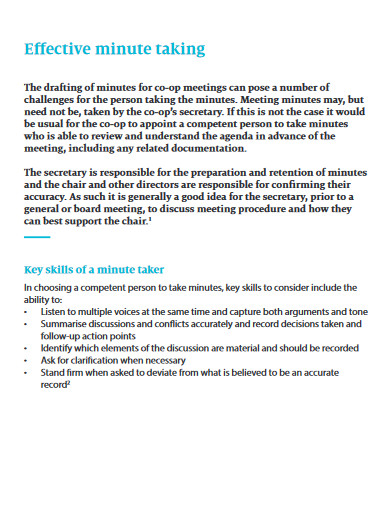
uk.coop
Details
File Format
PDF
Size: 255 KB
What Is Taking Minutes?
Taking minutes or also is a written record of all the things that happened at a meeting. They serve as a reminder to those who were unable to attend the conference. Also, this can help track the things agreed upon during the agreement. As such, you can revisit it and use it to guide future decisions. However, there are specific abilities that you may possess while taking a minute. Some of such are the following:
Active Listener
Detail-Oriented
Reasonably Confident
Equipped With Materials
How To Write Effective Meeting Minutes?
Preparing meeting minutes doesn’t have to be a difficult task either you are a secretary of your organization or only a member who asks to take note of everything. However, make sure that you are aware of the factors to consider when doing so. Because the minutes are a permanent record of the meeting, double-check them before submitting them. Make sure to run them by a supervisor or seasoned attendee to secure that information and statements accurately taken.
To get you started with writing, here are some steps to consider:
Step 1. Create an Agenda
Meetings happened for a reason. That’s why you should list down the issue that needs attention to alert your attendees. In this case, you can work with the convener to create a topic that assigns time to each problem. It can help you keep the meeting going and ensure that everyone has enough time to consider all items. The program serves as your outline for meeting minutes. So, keep the minute’s heading consistent with the list topics for continuity.
Step 2. Use a Template From Previous Minutes.
If you’re new to the organization, writing meeting minutes for the first time can be challenging. In this case, don’t hesitate to ask for the past notes to maintain the same format. The previous meetings can help you determine whether a quorum succeeds. Or if the other details unique to the organization’s meeting minutes.
Step 3. Record Attendance
In an organization meeting, the minute’s taker should arrive early before the meeting start. He or she should pass around the sheet that has all the member’s names and contact information. Attendees must check off their names and make any necessary changes to their data. It can serve as a backup document for attendees. As well as a way to guarantee that information sent are their current email addresses.
Step 4. Proofread Carefully
In taking minutes, you no need to write down everything. There are only specific factors that you need t take note like checking the spelling, date of the meeting, and the minutes. Don’t forget to pell out acronyms, especially if it’s their first time to attend. Stay consistent with the punctuation, heading, and formatting. The minutes should be professionals.
FAQs:
What’s the importance of taking minutes?
As a glimpse, meeting minutes are detailed documents of the proceedings to take place during a meeting. It highlights the essential details, assignments, and decisions. With this, you can avoid misunderstandings and disagreements because you can review the minutes and determine what occurred unusually at the conference.
What is involved in meeting minutes?
When it comes to meeting minutes, people are unaware of the things that need to take note of. And this will be an extensive problem in the end. As a staff member or even a manager, do some research before you start. Don’t risk your project because of such reasons. Some of the factors that involve taking minutes are; date and time, name of the participants, acceptance or corrections, and decisions made about each plan.
What’s the most challenging part of writing meeting minutes?
Knowing what to write down and what to leave out is one of the most complex aspects of taking minutes. Remember these two key points: Do not try to write everything on your sheet– it’s impossible and useless. Minutes are not a verbatim statement of what was said.
Meeting minutes don’t have to be hard to write. There are tools and meeting minute templates that you can get online. Either you are recording company-wide conference calls or only syncing up with your current project, make use of your time smartly. Take the sample templates above!

